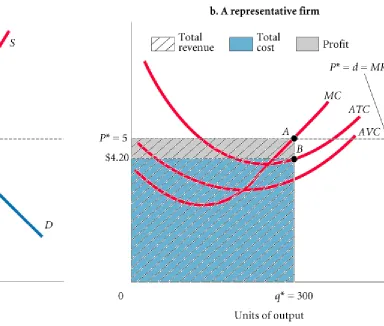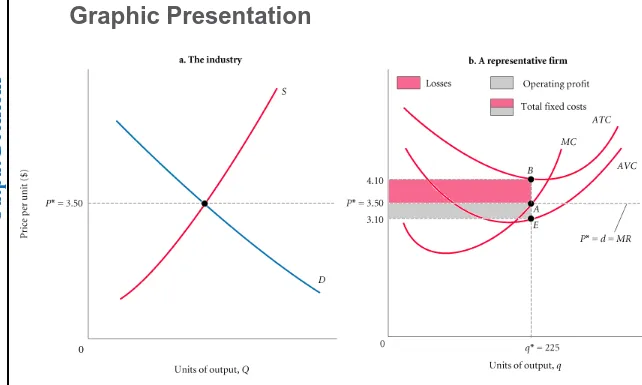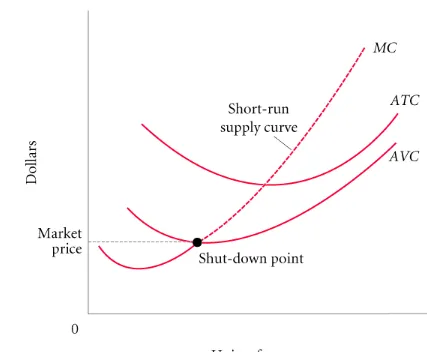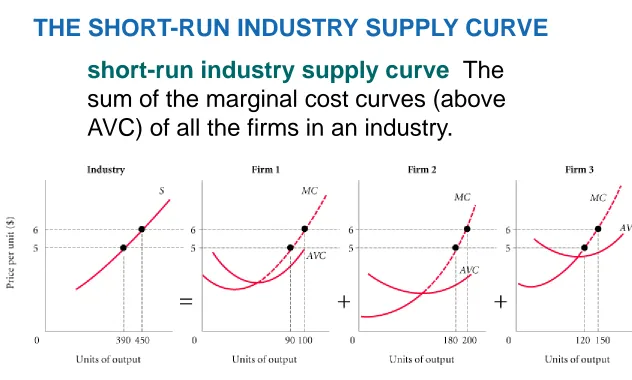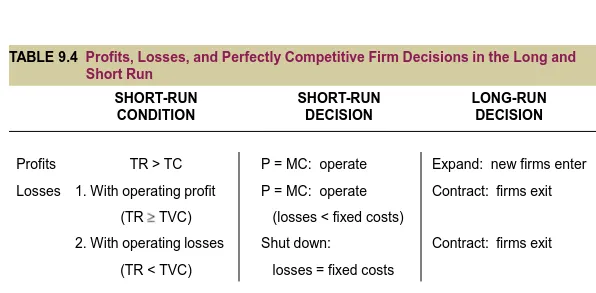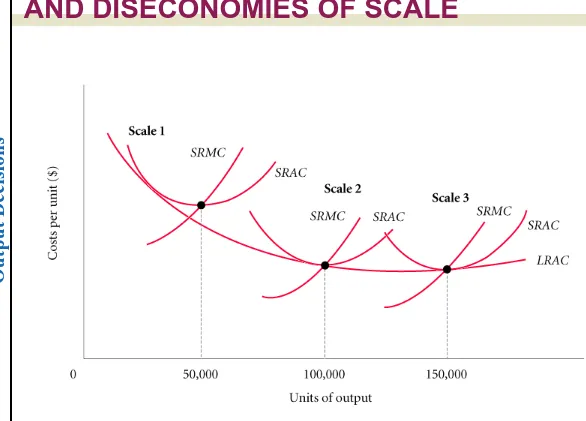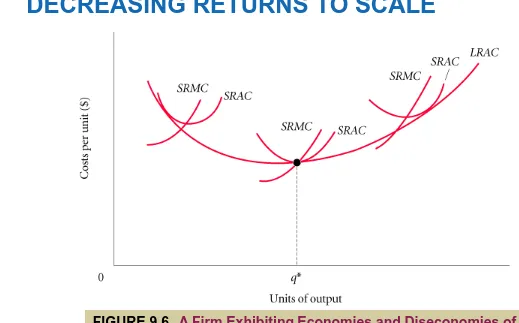Prepared by:
Fernando & Yvonn
Quijano
9
Chapter
Long-Run Costs
CH
© 2007 Prentice Hall Business Publishing Principles of Economics 8e by Case and Fair 2 of 36
Chapter Outline
9
Long-Run Costs
and Output Decisions
Short-Run Conditions and Long- Run Directions
Maximizing Profits Minimizing Losses
The Short-Run Industry Supply Curve Long-Run Directions: A Review
Long-Run Costs: Economies and Diseconomies of Scale
Increasing Returns to Scale Constant Returns to Scale Decreasing Returns to Scale
Long-Run Adjustments to Short-Run Conditions
Short-Run Profits: Expansion to Equilibrium Short-Run Losses: Contraction to Equilibrium The Long-Run Adjustment Mechanism: Investment Flows toward Profit Opportunities
Output Markets: A Final Word Appendix: External Economies and
CH
LONG-RUN COSTS AND OUTPUT DECISIONS
We begin our discussion of the long run by looking at firms
in three short-run circumstances:
(1)
firms earning economic profits,
(2)
firms suffering economic losses but continuing to
operate to reduce or minimize those losses, and
CH
© 2007 Prentice Hall Business Publishing Principles of Economics 8e by Case and Fair 4 of 36
SHORT-RUN CONDITIONS
AND LONG-RUN DIRECTIONS
breaking even The situation in which a
firm is earning exactly a normal rate of
return.
Example: The Blue Velvet Car Wash
MAXIMIZING PROFITS
TABLE 9.1
Blue Velvet Car Wash Weekly Costs
TOTAL FIXED COSTS (TFC)
TOTAL VARIABLE COSTS (TVC) (800 WASHES)
TOTAL COSTS
Total revenue (TR)
at P = $5 (800 x $5) $ 4,000
2. Other fixed costs (maintenance contract,
insurance, etc.) 1,000
$ 1,600 Profit (TR TC) $ 400
CH
AND LONG-RUN DIRECTIONS
Graphic Presentation
CH
© 2007 Prentice Hall Business Publishing Principles of Economics 8e by Case and Fair 6 of 36
SHORT-RUN CONDITIONS
AND LONG-RUN DIRECTIONS
MINIMIZING LOSSES
operating profit (or loss) or net
operating revenue Total revenue minus
total variable cost (TR TVC).
In general,
■
If revenues exceed variable costs, operating
profit is positive and can be used to offset fixed
costs and reduce losses, and it will pay the firm
to keep operating.
CH
AND LONG-RUN DIRECTIONS
Producing at a Loss to Offset Fixed Costs:
The Blue Velvet Revisited
TABLE 9.2
A Firm Will Operate If Total Revenue Covers Total Variable Cost
CH
© 2007 Prentice Hall Business Publishing Principles of Economics 8e by Case and Fair 8 of 36
SHORT-RUN CONDITIONS
AND LONG-RUN DIRECTIONS
Graphic Presentation
CH
AND LONG-RUN DIRECTIONS
ATC
=
AFC
+
AVC
or
AFC = ATC AVC =
$4.10 $3.10 = $1.00
Remember that average total cost is equal to average
fixed cost plus average variable cost. This means that
at every level of output, average fixed cost is the
difference between average total and average variable
cost:
CH
© 2007 Prentice Hall Business Publishing Principles of Economics 8e by Case and Fair 10 of 36
SHORT-RUN CONDITIONS
AND LONG-RUN DIRECTIONS
Shutting Down to Minimize Loss
TABLE 9.3
A Firm Will Shut Down If Total Revenue Is Less Than Total Variable Cost
CASE 1: SHUT DOWN
CASE 2: OPERATE AT PRICE = $1.50
CH
AND LONG-RUN DIRECTIONS
The short-run supply curve of a competitive firm is that portion of its marginal cost
curve that lies above its average variable cost curve (Figure 9.3).
shut-down point The lowest point on the
average variable cost curve. When price
falls below the minimum point on AVC,
total revenue is insufficient to cover
CH
© 2007 Prentice Hall Business Publishing Principles of Economics 8e by Case and Fair 12 of 36
SHORT-RUN CONDITIONS
AND LONG-RUN DIRECTIONS
CH
AND LONG-RUN DIRECTIONS
FIGURE 9.4
The Industry Supply Curve in the Short Run Is the Horizontal Sum of
the Marginal Cost Curves (above AVC) of All the Firms in an Industry
short-run industry supply curve The
sum of the marginal cost curves (above
AVC) of all the firms in an industry.
CH
© 2007 Prentice Hall Business Publishing Principles of Economics 8e by Case and Fair 14 of 36
SHORT-RUN CONDITIONS
AND LONG-RUN DIRECTIONS
LONG-RUN DIRECTIONS: A REVIEW
TABLE 9.4
Profits, Losses, and Perfectly Competitive Firm Decisions in the Long and
Short Run
2. With operating losses
Shut down:
Contract: firms exit
CH
LONG-RUN COSTS: ECONOMIES
AND DISECONOMIES OF SCALE
increasing returns to scale, or economies of
scale
An increase in a firm’s scale of production
leads to lower costs per unit produced.
constant returns to scale An increase in a
firm’s scale of production has no effect on costs
per unit produced.
decreasing returns to scale, or diseconomies
of scale
An increase in a firm’s scale of
CH
© 2007 Prentice Hall Business Publishing Principles of Economics 8e by Case and Fair 16 of 36
LONG-RUN COSTS: ECONOMIES
AND DISECONOMIES OF SCALE
INCREASING RETURNS TO SCALE
The Sources of Economies of Scale
Most of the economies of scale that immediately
come to mind are technological in nature.
CH
LONG-RUN COSTS: ECONOMIES
AND DISECONOMIES OF SCALE
Example: Economies of Scale in Egg Production
TABLE 9.5
Weekly Costs Showing Economies of Scale in Egg Production
JONES FARM
TOTAL WEEKLY COSTS
15 hours of labor (implicit value $8 per hour)
$120
Feed, other variable costs
25
Transport costs
15
Land and capital costs attributable to egg production
17
$177
Total output
2,400 eggs
Average cost
$.074 per egg
CHICKEN LITTLE EGG FARMS INC.
TOTAL WEEKLY COSTS
Labor
$ 5,128
Feed, other variable costs
4,115
Transport costs
2,431
Land and capital costs
19,230
$30,904
Total output
1,600,000 eggs
CH
© 2007 Prentice Hall Business Publishing Principles of Economics 8e by Case and Fair 18 of 36
LONG-RUN COSTS: ECONOMIES
AND DISECONOMIES OF SCALE
Graphic Presentation
CH
LONG-RUN COSTS: ECONOMIES
AND DISECONOMIES OF SCALE
CH
© 2007 Prentice Hall Business Publishing Principles of Economics 8e by Case and Fair 20 of 36
LONG-RUN COSTS: ECONOMIES
AND DISECONOMIES OF SCALE
CONSTANT RETURNS TO SCALE
Technically, the term constant returns means that the
quantitative relationship between input and output stays
constant, or the same, when output is increased.
CH
LONG-RUN COSTS: ECONOMIES
AND DISECONOMIES OF SCALE
DECREASING RETURNS TO SCALE
FIGURE 9.6
A Firm Exhibiting Economies and Diseconomies of Scale
CH
© 2007 Prentice Hall Business Publishing Principles of Economics 8e by Case and Fair 22 of 36
LONG-RUN COSTS: ECONOMIES
AND DISECONOMIES OF SCALE
optimal scale of plant The scale of plant
that minimizes average cost.
CH
LONG-RUN ADJUSTMENTS
TO SHORT-RUN CONDITIONS
THE LONG-RUN ADJUSTMENT MECHANISM:
INVESTMENT FLOWS TOWARD PROFIT
OPPORTUNITIES
In efficient markets, investment capital flows toward profit opportunities.
The actual process is complex and varies from industry to industry.
When firms in an industry are making
positive profits, capital is likely to flow
into that industry. Entrepreneurs start
new firms, and firms producing entirely
different products may join the
CH
© 2007 Prentice Hall Business Publishing Principles of Economics 8e by Case and Fair 24 of 36
